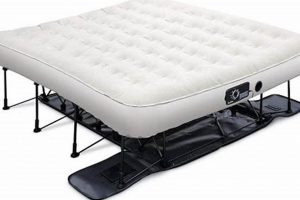The inquiry centers on the recurring loss of air pressure in inflatable mattresses, a common issue affecting their usability and longevity. It addresses the question of what causes an air mattress to lose its intended firmness over time, leading to discomfort and requiring frequent reinflation.
Understanding the reasons behind this deflation is important for maximizing the lifespan and utility of air mattresses. Addressing the underlying causes of air loss ensures a more restful sleep experience and prevents unnecessary replacement costs. This knowledge empowers users to properly maintain and troubleshoot issues with their air mattresses, extending their usability.
Several factors can contribute to the decrease in air pressure within an inflatable mattress. These include puncture damage, valve malfunctions, temperature fluctuations, material degradation, and seam leaks. The following sections will explore each of these possibilities in detail, providing diagnostic information and potential solutions.
Troubleshooting Air Mattress Deflation
Examining potential solutions when an air mattress loses pressure requires a systematic approach to identify and address the underlying cause. The following points offer guidance in pinpointing and resolving common issues.
Tip 1: Conduct a Visual Inspection: Examine the entire surface of the air mattress for visible punctures, tears, or abrasions. Pay close attention to seams and areas prone to stress. Use a bright light to illuminate the surface, aiding in the detection of small holes.
Tip 2: Perform a Soap Test: Mix a solution of mild soap and water, and apply it to sections of the mattress. Slowly compress the mattress, observing for bubbles. Bubbles indicate the location of an air leak, even if the puncture is microscopic.
Tip 3: Inspect the Valve Mechanism: Ensure the valve is properly sealed and free of debris. A faulty valve can be a significant source of slow air loss. Clean the valve area with a damp cloth to remove any particles that may be preventing a tight seal.
Tip 4: Consider Temperature Effects: Be aware that temperature changes can affect air pressure inside the mattress. A drop in temperature will cause the air to contract, potentially leading to the perception of deflation. Adjust the air pressure accordingly in such circumstances.
Tip 5: Check the Seams: Closely examine the seams of the air mattress, where the material is joined. Seams are a common point of failure due to stress and wear. Apply the soap test specifically along seam lines.
Tip 6: Evaluate the Environment: Ensure the mattress is placed on a smooth, debris-free surface. Sharp objects or rough textures can cause punctures over time. Use a protective layer, such as a mattress pad or blanket, to minimize friction and abrasion.
By systematically addressing these potential causes, one can effectively identify the source of air loss and implement appropriate repair measures. This proactive approach prolongs the life of the mattress and ensures continued usability.
Implementing these tips as a preventative measure helps mitigate future issues and ensures optimal performance of the air mattress. The following section will discuss long-term maintenance strategies.
1. Puncture Identification
Puncture identification represents a critical step in resolving sustained air loss from inflatable mattresses. A puncture, defined as a breach in the mattress’s airtight barrier, directly facilitates air escape. This escape results in diminished firmness and, over time, complete deflation. The relationship is causal: the presence of a puncture is the direct reason the mattress loses air.
The importance of puncture identification lies in its role as the primary diagnostic element. Without locating the point of air leakage, any attempts at repair are essentially guesswork. For example, a seemingly slow leak may render the mattress unusable after only a few hours, requiring multiple re-inflations during a single night. A systematic examination for punctures, therefore, becomes crucial to address this problem. A small pinhole, easily overlooked, can lead to gradual, persistent deflation. Similarly, larger tears caused by sharp objects result in rapid and noticeable air loss.
Effective puncture identification is not merely an isolated task but an integral part of maintaining the air mattress’s functionality. The successful location of a puncture allows for targeted repairs. This targeted approach minimizes wasted effort and restores the mattress to its intended state. Failure to locate and repair even a small puncture ensures the continuation of air loss, thus negating any benefit derived from reinflation or other temporary solutions. Therefore, thorough puncture identification is the foundation for effective air mattress maintenance.
2. Valve Integrity
Valve integrity constitutes a critical factor in the context of air retention within inflatable mattresses. A compromised valve, whether due to physical damage, debris accumulation, or material degradation, directly contributes to sustained air loss. The valve’s primary function is to maintain an airtight seal, preventing the escape of pressurized air. Any malfunction within this mechanism results in a gradual or rapid decrease in the mattress’s inflation level. The relationship between valve condition and air retention is fundamentally causal; a defective valve invariably leads to deflation.
The importance of valve integrity extends beyond mere air retention. A properly functioning valve facilitates efficient inflation and deflation, simplifying the setup and storage processes. Conversely, a faulty valve presents challenges in achieving and maintaining the desired firmness, requiring repeated inflation attempts and rendering the mattress unreliable for sustained use. Consider, for example, a scenario where the valve’s sealing mechanism becomes warped or cracked due to prolonged exposure to extreme temperatures. In such instances, even minute distortions can disrupt the airtight seal, leading to a slow but consistent air leak that gradually undermines the mattress’s usability.
In summation, valve integrity represents an indispensable component in ensuring the long-term performance of inflatable mattresses. Maintaining the valve in optimal condition, through regular inspection, cleaning, and appropriate storage practices, directly mitigates the risk of air leakage and prolongs the mattress’s lifespan. Addressing valve-related issues promptly can prevent recurring deflation problems and maintain the intended comfort and support characteristics of the product. Failure to recognize and address valve integrity issues will inevitably lead to persistent air loss and diminished user satisfaction.
3. Seam Weakness
Seam weakness is a significant contributing factor to sustained air loss in inflatable mattresses, directly influencing their ability to maintain inflation. Seams represent the points where separate pieces of material are joined to form the mattress’s structure. These areas are inherently more susceptible to failure due to the concentrated stress and strain they endure during inflation, deflation, and normal use. A compromised seam, characterized by weakened adhesive bonds or material fatigue, provides a pathway for air to escape, leading to gradual or rapid deflation. The degradation of seam integrity is a direct cause-and-effect relationship with the observed phenomenon of air mattresses losing pressure.
The importance of seam integrity lies in its role as a structural element. A failure in the seams compromises the mattress’s ability to provide consistent support and maintain its intended shape. Consider, for example, the case of an air mattress used frequently for overnight guests. Over time, the repeated inflation and deflation cycles, coupled with the weight of occupants, can weaken the seams, particularly around the edges. This weakening may initially manifest as a slight bulge or distortion, followed by a gradual loss of air pressure. Even small seam imperfections, invisible to the naked eye, can cause noticeable deflation over several hours. Addressing seam weakness requires specialized repair techniques, often involving the application of fabric patches and adhesives designed to restore the integrity of the bond.
In conclusion, seam weakness represents a critical consideration in understanding the persistent issue of inflatable mattress deflation. Recognizing the vulnerability of seams to stress and wear allows for preventative measures such as proper inflation practices and careful storage to minimize strain. Addressing seam-related problems with appropriate repair solutions effectively prolongs the lifespan and usability of the mattress, ensuring continued comfort and support. Failure to acknowledge and rectify seam weakness issues will inevitably result in ongoing air loss, thereby reducing the overall effectiveness and value of the inflatable mattress.
4. Temperature Influence
Temperature variations exert a discernible influence on the air pressure within inflatable mattresses, directly impacting their inflation level. Air, like other gases, expands when heated and contracts when cooled. Consequently, when the ambient temperature decreases, the air inside the mattress undergoes a reduction in volume, leading to a perceived loss of pressure. Conversely, an increase in temperature results in air expansion, potentially causing the mattress to become firmer. These temperature-induced pressure changes contribute to the phenomenon.
The effect of temperature fluctuations is particularly relevant in environments where temperature is not consistently controlled. For example, an air mattress used for camping in the outdoors may experience significant deflation overnight as temperatures drop. Similarly, a mattress placed near a drafty window or in an unheated room is susceptible to temperature-related pressure changes. The extent of pressure change is proportional to the magnitude of the temperature shift and the volume of air within the mattress. It is important to note that this fluctuation does not necessarily indicate an air leak. Adjusting the air pressure in response to temperature variations is therefore a necessary aspect of maintaining optimal comfort.
Understanding the relationship between temperature and air pressure in mattresses is critical for troubleshooting deflation issues and ensuring satisfactory performance. Failure to account for temperature-related pressure changes may lead to unnecessary concerns about leaks or mattress defects. When confronted with a perceived deflation, it is prudent to consider the environmental temperature before pursuing more complex diagnostic procedures. By acknowledging and addressing the influence of temperature, users can more effectively manage air mattress inflation and prolong their overall utility.
5. Material Degradation
Material degradation plays a significant role in the recurring deflation of inflatable mattresses. The materials used in these mattresses, typically polyvinyl chloride (PVC) or similar polymers, are subject to gradual breakdown over time due to various factors, including exposure to ultraviolet (UV) radiation, temperature fluctuations, humidity, and repeated stress from inflation and deflation cycles. This deterioration reduces the material’s elasticity and tensile strength, making it more prone to developing microscopic cracks and weakening seams, thereby creating pathways for air leakage.
The importance of material degradation as a component of recurring deflation lies in its insidious nature. Unlike a puncture from a sharp object, which is immediately noticeable, material degradation progresses slowly and often imperceptibly until it reaches a critical point where air loss becomes apparent. For instance, prolonged exposure to sunlight can cause PVC to become brittle and less pliable, increasing its susceptibility to cracking, particularly in areas that experience repeated bending or stretching. Similarly, the repeated expansion and contraction of the material during inflation and deflation cycles can cause microscopic tears to develop over time, eventually coalescing into larger leaks.
Understanding the link between material degradation and air mattress deflation is essential for informed maintenance and purchasing decisions. Consumers should consider mattresses constructed from higher-quality, more durable materials that are resistant to UV radiation and other forms of environmental degradation. Furthermore, storing air mattresses properly, away from direct sunlight and extreme temperatures, can significantly prolong their lifespan. Recognizing the effects of material degradation allows for preventative measures, extending the mattress’s usability and reducing the frequency of deflation issues.
6. Over-Inflation
Over-inflation represents a significant factor contributing to the recurring deflation issues experienced with inflatable mattresses. While seemingly counterintuitive, exceeding the recommended inflation pressure can compromise the mattress’s structural integrity and accelerate air leakage.
- Stretching of Material
Over-inflation forces the mattress material beyond its designed elasticity. This excessive stretching weakens the polymer structure, creating microscopic fissures and thinning the material, thereby facilitating air permeation over time. A common example is when an individual inflates an air mattress to maximum capacity, believing it will provide superior firmness; however, this strains the seams and weakens the overall material integrity.
- Seam Stress and Failure
The seams of an inflatable mattress are particularly vulnerable to over-inflation. These joined areas are designed to withstand a specific pressure threshold. Exceeding this limit places undue stress on the a
dhesive bonds or welded seams, leading to separation or micro-tears that allow air to escape. For instance, inflating an air mattress beyond the fill line often results in seam rupture, evidenced by bulging areas or hissing sounds indicating air leakage. - Valve Damage
The inflation valve is also susceptible to damage from excessive pressure. Over-inflation can warp the valve’s sealing mechanism, preventing it from creating a tight seal and allowing air to slowly leak out. An example of this is when a user continues to pump air into the mattress even after the valve indicates it is full, damaging the internal components and compromising its ability to maintain pressure.
- Compromised Baffles
Internal baffles are structures within the air mattress that help distribute air evenly and maintain shape. Over-inflation can damage or rupture these internal supports, leading to uneven pressure distribution and localized stress on the mattress material, increasing the likelihood of deflation. Consider an air mattress used frequently for guests; over-inflation can weaken the baffles, causing them to collapse and create areas of concentrated stress, ultimately leading to air leaks.
In summary, the act of over-inflating an air mattress, while often intended to increase firmness, initiates a cascade of detrimental effects that ultimately contribute to its recurring deflation. Material stretching, seam stress, valve damage, and baffle compromise are all consequences of exceeding the recommended inflation pressure, highlighting the importance of adhering to manufacturer guidelines to prolong the mattress’s lifespan.
7. Improper Storage
Inadequate storage practices significantly contribute to the recurring deflation issues observed in inflatable mattresses. Failure to properly store these mattresses subjects them to conditions that accelerate material degradation, compromise structural integrity, and ultimately lead to air leakage.
- Exposure to Temperature Extremes
Storing air mattresses in environments with extreme temperature fluctuations, such as attics or garages, accelerates material degradation. Elevated temperatures can cause the plastic to become brittle and prone to cracking, while freezing temperatures reduce elasticity and increase the risk of punctures. For example, storing a deflated mattress in a non-climate-controlled garage over winter exposes it to freezing temperatures, making it more susceptible to damage upon subsequent inflation. This damage contributes to air loss.
- Exposure to Direct Sunlight
Prolonged exposure to direct sunlight causes ultraviolet (UV) radiation damage to the mattress material. UV light degrades the polymers in the PVC or similar materials, leading to brittleness, discoloration, and a reduced ability to maintain air pressure. An air mattress left unfolded in a sunlit room for extended periods will experience accelerated material breakdown, resulting in increased air permeability and deflation.
- Folding and Creasing
Improper folding and storage practices can create sharp creases and stress points in the mattress material. These creases weaken the material, making it more susceptible to punctures or tears over time. Consistently folding the mattress along the same lines creates persistent stress points, which eventually lead to material failure and air leakage. For example, repeatedly folding a mattress in the same manner causes wear along the fold lines, creating weak points where air can escape.
- Exposure to Puncturing Objects
Storing an air mattress in proximity to sharp or abrasive objects increases the risk of accidental punctures. Even when deflated, the material can be compromised by contact with sharp edges, tools, or debris. If, for example, a deflated mattress is stored in a closet alongside gardening tools, the risk of punctures from the tools increases significantly, leading to subsequent deflation when the mattress is inflated.
These examples demonstrate how seemingly innocuous storage habits can substantially reduce the lifespan and performance of inflatable mattresses. By understanding the mechanisms through which improper storage contributes to deflation, users can implement preventative measures, preserving the mattress’s integrity and prolonging its usability.
Frequently Asked Questions About Inflatable Mattress Deflation
This section addresses common inquiries concerning the persistent deflation of air mattresses. The following questions provide comprehensive explanations and insights into underlying causes and potential solutions.
Question 1: Is some air loss in an air mattress normal?
A slight decrease in air pressure over extended periods is generally expected due to the porous nature of the material and minor temperature fluctuations. However, significant and frequent deflation indicates an underlying issue that requires investigation.
Question 2: How can punctures be effectively located?
A soap solution applied to the inflated mattress can reveal even minute punctures. The formation of bubbles at the site of air leakage identifies the source of the problem. A thorough visual inspection under bright light can also aid in detecting larger tears or abrasions.
Question 3: What is the expected lifespan of an air mattress valve?
The longevity of a valve depends on usage frequency and maintenance. Regularly cleaning the valve area to remove debris and avoiding over-tightening can extend its lifespan. A damaged or worn valve necessitates replacement to maintain airtight integrity.
Question 4: Does the weight of the user affect the rate of deflation?
Excessive weight can exacerbate existing issues such as weakened seams or material fatigue, leading to accelerated deflation. Exceeding the mattress’s weight capacity places undue stress on its structure.
Question 5: Can air mattresses be repaired effectively?
Minor punctures and seam leaks can often be repaired using patch kits designed for inflatable materials. Larger tears or extensive material degradation may render the mattress irreparable, necessitating replacement.
Question 6: How does humidity impact air mattress deflation?
High humidity levels can contribute to material degradation over time, particularly in storage. Moisture can promote the growth of mold and mildew, which weaken the structural integrity of the mattress material.
Addressing these questions allows for a more informed approach to troubleshooting and preventing air mattress deflation, prolonging the mattress’s usability. Prioritize careful storage and regular maintenance.
The subsequent section will explore preventative measures aimed at minimizing the occurrence of deflation.
Addressing Persistent Air Loss in Inflatable Mattresses
This discourse has comprehensively examined various causative factors contributing to the recurring deflation of inflatable mattresses. These include material degradation, puncture damage, valve malfunction, temperature influence, seam weaknesses, over-inflation, and improper storage practices. The interrelation of these elements underscores the multifaceted nature of the problem, necessitating a thorough approach to diagnosis and remediation.
The persistent inquiry into “why does my air mattress keep deflating” highlights the necessity for vigilance in maintenance and adher
ence to recommended usage protocols. Failure to recognize and address these contributing factors will invariably result in diminished product lifespan and compromised user experience. Prioritizing proactive measures and diligent monitoring will maximize the utility of inflatable mattresses and mitigate the inconvenience of recurring air loss.







